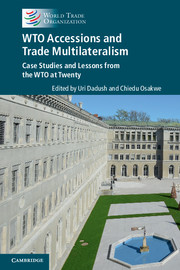Book contents
- Frontmatter
- Dedication
- Contents
- List of contributors
- Foreword
- Acknowledgements
- List of abbreviations
- Editors' note
- PART I WTO accessions, the trading system and the global economy
- 1 A reflection on accessions as the WTO turns twenty
- 2 Developments in the global economy and trading system effects: the transformation of world trade
- 3 The WTO and the global economy: contemporary challenges and possible responses
- 4 The structural reform implications of WTO accession
- 5 The macroeconomic implications of WTO accession
- 6 The future of Asia: unleashing the power of trade and governance
- 7 Eurasian Economic Union integration: timetable, priorities and challenges
- 8 WTO accessions: what does the academic literature say?
- PART II Overview: systemic outcomes from accessions
- PART III Members’ perspectives on accession negotiations
- PART IV Working party chairpersons’ perspectives on accession negotiations
- PART V Salient features inWTOAccession Protocols
- PART VI Conclusion
- Annex: Contributor biographies
- Index
- Plate section
- References
3 - The WTO and the global economy: contemporary challenges and possible responses
from PART I - WTO accessions, the trading system and the global economy
Published online by Cambridge University Press: 05 November 2015
- Frontmatter
- Dedication
- Contents
- List of contributors
- Foreword
- Acknowledgements
- List of abbreviations
- Editors' note
- PART I WTO accessions, the trading system and the global economy
- 1 A reflection on accessions as the WTO turns twenty
- 2 Developments in the global economy and trading system effects: the transformation of world trade
- 3 The WTO and the global economy: contemporary challenges and possible responses
- 4 The structural reform implications of WTO accession
- 5 The macroeconomic implications of WTO accession
- 6 The future of Asia: unleashing the power of trade and governance
- 7 Eurasian Economic Union integration: timetable, priorities and challenges
- 8 WTO accessions: what does the academic literature say?
- PART II Overview: systemic outcomes from accessions
- PART III Members’ perspectives on accession negotiations
- PART IV Working party chairpersons’ perspectives on accession negotiations
- PART V Salient features inWTOAccession Protocols
- PART VI Conclusion
- Annex: Contributor biographies
- Index
- Plate section
- References
Summary
ABSTRACT
The high economic growth rates that have been achieved by many countries in Asia have led to a contemporary world economy that is multipolar. This has had repercussions for the WTO, as well as for other multilateral organisations. The deadlock in the WTO's Doha Round has led the United States and the European Union increasingly to turn their attention towards the negotiation of preferential trade agreements, including so-called ‘mega-regional’ partnerships. This chapter discusses some of the implications for – and possible responses by – the economies that have the greatest stake in a well-functioning multilateral trading system. These economies may find themselves caught in the midst of disagreements between the major trading nations, with few prospects of participating in the mega-regionals. The chapter argues that these economies – including those that have acceded to the WTO since its creation – need to take a more proactive leadership role in the WTO to enhance the transparency of what is done in the ‘megaregionals’ and to facilitate the pursuit of rule-making initiatives in the WTO on a plurilateral basis.
The global trade regime embodied in the General Agreement on Tariffs and Trade (GATT)/WTO has provided an important framework for countries to agree to trade policy disciplines and commitments, as well as a mechanism through which these can be enforced. After the limited membership of low-income countries in the GATT in 1948 – twelve of the original twenty-three signatories were developing economies – in the 1960s there was a substantial expansion of developing country membership. With the creation of the WTO, membership continued to expand steadily, standing at 161 currently, up from 128 in 1995. Twenty-three countries are in the process of negotiating accession.
Developing country engagement in the WTO has been based on the premise of ‘more favourable’ or ‘special and differential treatment’ (S&D). This takes several forms. One is acceptance by the WTO membership of higher trade barriers in developing nations and ‘less than full reciprocity’ in multilateral trade negotiations. Another is a promise by high-income countries to provide preferential access to their markets for exports from developing countries – through the Generalised System of Preferences (GSP) or through better than GSP treatment – duty-free, quota-free (DFQF) access for the least-developed countries (LDCs). A third dimension involves exceptions and exemptions from specific disciplines.
- Type
- Chapter
- Information
- WTO Accessions and Trade MultilateralismCase Studies and Lessons from the WTO at Twenty, pp. 52 - 80Publisher: Cambridge University PressPrint publication year: 2015



